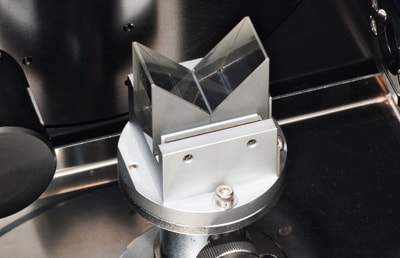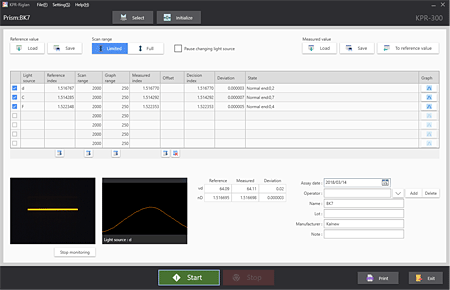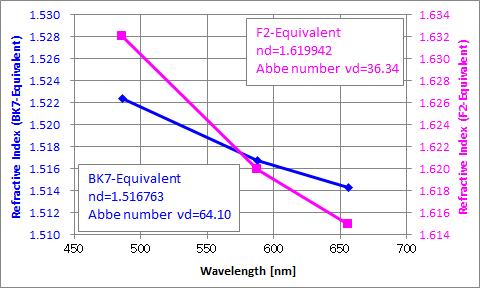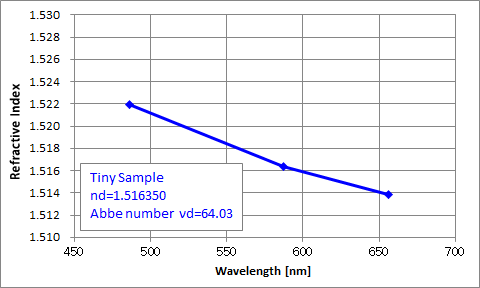The KPR-300 is a digital refractometer that measures the refractive indices of glass and other optical materials using the V-block method (Vee-block or Hilger-Chance method).
The KPR-300 equipped with multiple spectral lamps measures refractive indices at multiple wavelengths, and can calculate Abbe numbers.
Thanks to special software, multi-wavelength refractive index measurements are performed with a single click, and Abbe numbers are also calculated automatically.
Optical materials (glass and resin) with reliable refractive indices and Abbe numbers are required for high-quality optical systems corrected for chromatic aberration.
Accordingly, the manufacturing of high-quality optical glass and lenses requires a method for monitoring the status of the materials efficiently and reliably.
The Kalnew precision refractometer, which consistently provides accurate refractive index measurements, is a powerful means of satisfying these needs.

Features
V-Block Method (Vee-Block or Hilger-Chance Method) Adopted
With the V-block method, samples finished to a 90 degree angle are measured. The instrument is capable of high-accuracy measurements (in comparison to the Abbe method (critical angle method)), with a measurement accuracy of ±4 × 10-5, and a display resolution of 0.1 × 10-5.
The finished surface of the sample does not require the finished accuracy of general spectrometer prisms, and a grinding finish is enough (polishing the surface is not required), so sample preparation is not time consuming. The instrument can also measure small lenses with several millimeters in diameter, used in in-vehicle cameras and smartphones.

Multi-Wavelength Measurements at Three Wavelengths, the d-Line, C-Line, and F-Line
The instrument is equipped with two spectral lamps, and is capable of measuring refractive indices at the three wavelengths required for optical design, as well as calculations of scatter (Abbe number (νd)).

Capable of Measuring High Refractive Indices of 1.8 or Higher
A wide range of refractive indices can be measured by replacing the sample holder V-block prism. The instrument can measure refractive indices of 1.8 or higher, which is difficult with the Abbe method.
Automatic Measurements Thanks to Special Software
With a single click, the user can switch measurement wavelength, calculate the refractive index, and calculate the Abbe number.

Applications
Refractive index measurements for transparent solid samples.
(ex. lens, optical glass and plastic, near net-shape blanks, Molded lens)
Measurement example
Optical Glass
Even for optical glass for grinding, which features stable optical characteristics, the general tolerance with respect to catalog values is ±0.0003 of the refractive index and ±0.5 % of the Abbe number. Accordingly, control by actual measurements is important for maintaining stable optical performance. A measurement example (graph and measured values) is shown below for crown glass and flint glass used in achromatic lenses. The accuracy required (resolution to 6 decimal points) to assess the optical performance for both the refractive index and the Abbe number is evident.

Tiny Samples
With the molded lenses used in smartphones, the refractive index varies with the thermal history during molding. Accordingly, control via actual measurements is needed for quality control. A measurement example (graph and measurement values) is shown below for tiny sample with a diameter on the order of 3 mm and a thickness of 1 mm. Comparable results are obtained as for the optical glass at top, and it is evident that even small samples that would be difficult to measure with spectrometers or other measurement systems can be measured.

Specifications
| Measurement Method | V-block method |
|---|---|
| Measurement Range*1 | 1.20 to 2.05 |
| Measurement Accuracy*2 | Refractive index ±0.00004 (±4 × 10-5) |
| Measurement Repeatability*2 | Refractive index ±0.00001 (±1 × 10-5) |
| Reading Resolution | Refractive index 0.000001 (0.1 × 10-5) |
| Measurement Wavelengths | F-line 486.1 nm H2 lamp d-line 587.6 nm He lamp C-line 656.3 nm H2 lamp |
| Light Source | He lamp, H2 lamp |
| Light Detector | Photomultiplier tube |
| Main Accessories | V-block prisms, 2 types; Control software (for Windows), Standard test piece for calibration, Angle Gauge |
| Dimensions | Main unit: W404 × D609 × H290 mm Power supply: W152 × D360 × H277 mm |
| Weight | Main unit: 32 kg; Power supply: 6 kg |
| Power Consumption | 100 to 115 V AC, 196 VA, 50/60 Hz |
- *1 This is the measurement range when V-block prism 516-641A (nd = 1.52) and 773-496A (nd = 1.77) are used. 516-641A: 1.20 to 1.78; 773-496A: 1.45 to 2.05
- *2 This is the accuracy when measurements are performed in an environment with a temperature of 23 ℃ and a relative humidity of 45 to 85 %.
- *3 The specifications and configuration differ depending on the region of installation. For details, contact your Shimadzu representative.
This page may contain references to products that are not available in your country. Please contact us to check the availability of these products in your country.


